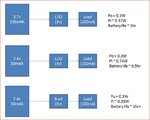faisal78
Member level 3
Hi
Need some advise.
I am making a portable device using Li-Ion batteries and battery life is my #1 priority.
My load on the battery is a MCU which is continously running and have a constant load.
In parallel to the battery I have a audio amplifier which can operate at 7.4v (louder) or 3.7v (softer)
Assuming I need a high performing audio (loud), it seems to be better to have my battery cells connected in series to provide 7.4v and add ~$1 for the additional buck regulator.
Did I get my calculations right?
I am assuming buck regulator efficiency of 90%.
Available cells are 50mAh. Parallel will give me 3.7v-100mA or series 7.4v-50mA.
Comments?
I am wondering based on the maths, why cellphones never implemented 7.4v series cells instead to have good audio and battery life? Assuming buck regulator costs are manageble?

Need some advise.
I am making a portable device using Li-Ion batteries and battery life is my #1 priority.
My load on the battery is a MCU which is continously running and have a constant load.
In parallel to the battery I have a audio amplifier which can operate at 7.4v (louder) or 3.7v (softer)
Assuming I need a high performing audio (loud), it seems to be better to have my battery cells connected in series to provide 7.4v and add ~$1 for the additional buck regulator.
Did I get my calculations right?
I am assuming buck regulator efficiency of 90%.
Available cells are 50mAh. Parallel will give me 3.7v-100mA or series 7.4v-50mA.
Comments?
I am wondering based on the maths, why cellphones never implemented 7.4v series cells instead to have good audio and battery life? Assuming buck regulator costs are manageble?
